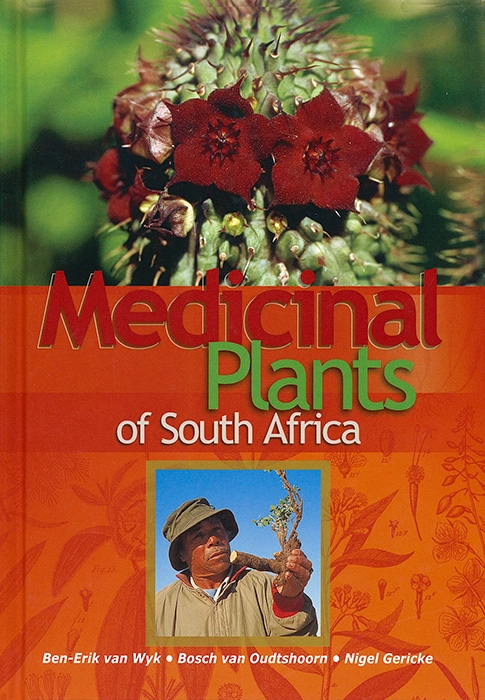Muthi and Myths from the African Bush, by Heather Dugmore and Ben-Erik van Wyk

Muthi and Myths from the African Bush, by Heather Dugmore and Ben-Erik van Wyk. Briza Publications. Pretoria, South Africa 2008. ISBN 9780958495493 / ISBN 978-0-9584954-9-3
Muthi and Myths from the African Bush, by Heather Dugmore and Ben-Erik van Wyk: Example: Guardian of the Grail.
Guardian of the Grail
Botanical name: Pelargonium sidoides
Common name: Umckaloabo (Zulu)
Should you be seeking the Holy Grail, head high into the mountains near Wellington in South Africa's Western Cape and there you will find Parceval; the Guardian of the Grail. The Holy Grail, as the story goes, is said to be the mystic chalice containing the mixture of blood and water that poured from Christ's chest when he was pierced with a sword while being crucified. This liquid is said to have been captured in a chalice and is widely believed that whoever has it in their possession through the ages, inherits the power to perform healing and life-restoring miracles. "What ails you?-" is the first question you will be asked on locating Parceval. Since something ails all of us - be it physical, psychological or spiritual - I am confident you won't be short of a reply. Not to lead you astray at this juncture, it won't be Parceval in person who asks what ails you, but rather horticulturist Ulrich Feiter, who twelve years ago started a medicinal plant farm in the mountains of Wellington, which he named Parceval. "I specialise in extracts of medicinal plants," says Ulrich. "When a large German pharmaceutical company called Schwabe approached me in 1996 to grow Pelargonium sidoides - or umckaloabo (ostensibly the Zulu term for 'heavy cough') - I started cultivating it here in Wellington." The lengthy collaboration between Parceval and Schwabe around this medicinal plant extract -which is widely used today to treat colds, flu, bronchitis and sinusitis - stands out as one of the success stories of an African medicinal plant abroad. Apart from the German market, Ulrich also cultivates Pelargonium sidoides for African-based clients who market it in pharmacies and health stores. Ulrich prefers not to discuss exactly how much of these plants he currently cultivates because competition between medicinal plant producers and distributors is accelerating each year. What is apparent is that Africa has an extraordinarily rich medicinal plant heritage that is only beginning to receive the recognition it deserves. Pelargonium sidoides is a member of the geranium family; it has round, velvety leaves, rich purple flowers and swollen tubers. Its wild populations extend from South Africa's Eastern Cape to the Kingdom of Lesotho. It has been used it for hundreds of years as a curative for coughs, upper respiratory tract irritations, gastrointestinal problems and ear infections. Traditionally it is also used to treat diarrhoea in cattle. It first reached the Western world when an Englishman named Charles Stevens was cured of his tuberculosis when treated in Lesotho with umcka-loabo in 1897. The story goes that Stevens came to Southern Africa because the climate is good for tuberculosis sufferers. During his stay he came across a Basuto sangoma from the Kingdom of Lesotho. The sangoma prescribed a decoction of umckaloabo roots for his condition and he fully recovered. He returned to England armed with this mysterious African remedy - which subsequently gained popularity throughout Europe as 'Stevens's Consumption Cure". Then in 1920, a former missionary doctor, Adrien Sechehaye, who had learned of Stevens's cure, published his medical case studies after successfully treating 800 patients for bronchial problems with a homeopathic preparation of the plant. [...]
This is an excerpt from Muthi and Myths from the African Bush, by Heather Dugmore and Ben-Erik van Wyk.
Title: Muthi and Myths from the African Bush
Authors: Heather Dugmore; Ben-Erik van Wyk
Publisher: Briza Publications
Pretoria, South Africa 2008
ISBN 9780958495493 / ISBN 978-0-9584954-9-3
Softcover, 21 x 26 cm, 128 pages, richly illustrated with colour photographs
Dugmore, Heather und van Wyk, Ben-Erik im Namibiana-Buchangebot
Muthi and Myths from the African Bush
52 compelling tales that lead on a journey of discovery of African plant mythology and its associated healing practices
People’s Plants: A Guide to Useful Plants of Southern Africa
In People’s Plants: A Guide to Useful Plants of Southern Africa traditional and contemporary uses of more than 700 plants are described and illustrated.
Cut flowers of the world
Cut Flowers of the World describes and illustrates more than 330 different species of commercially important flowers, foliages and potted flowers.
Medicinal plants of South Africa
Medicinal plants are an important aspect of the daily lives of many people and an important part of the South African cultural heritage.
Mind-altering and poisonous plants of the world
This book introduces to the better known poisonous and mind-altering plants of the world.
Food plants of the world
Food Plants of the World is a comprehensive overview of the plants that provide us with food, beverages, spices and flavours.
Medicinal plants of the world
Medicinal Plants of the World is a comprehensive and scientifically accurate guide to the best-known and most important medicinal plants, including those of special commercial or historical interest.
Mesembs of the world
This is a well-illustrated, easy-to-read guide of all the 123 mesembs genera that are currently recognised worldwide.
Photo Guide to Trees of Southern Africa
Photo Guide to Trees of Southern Africa is an invaluable identification and reference guide to 300 of the more common tree species.
Guide to the Aloes of South Africa
A wonderful guide to all 155 species aloes found in the South African field and in gardens.
Guide to Garden Succulents
Scientifically accurate photographic guide for gardeners and horticulturalist to easily identify commonly used species of succulents











